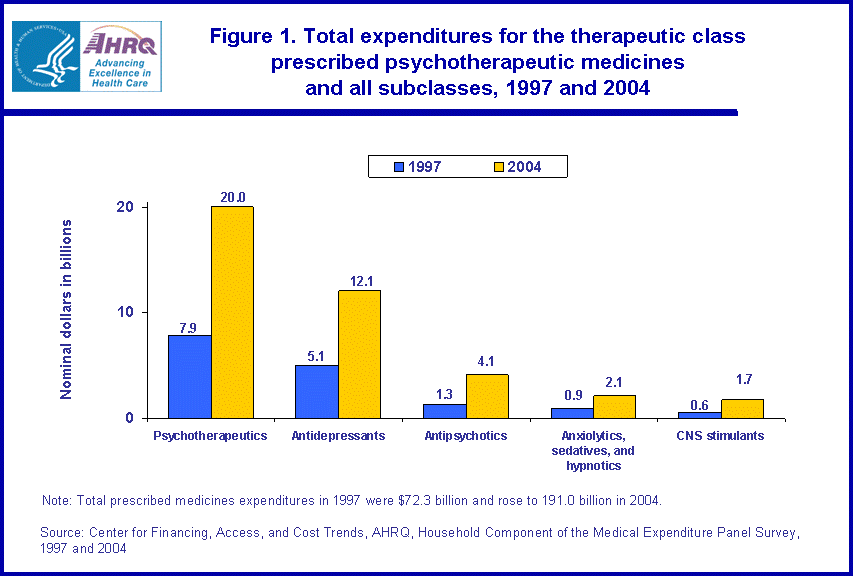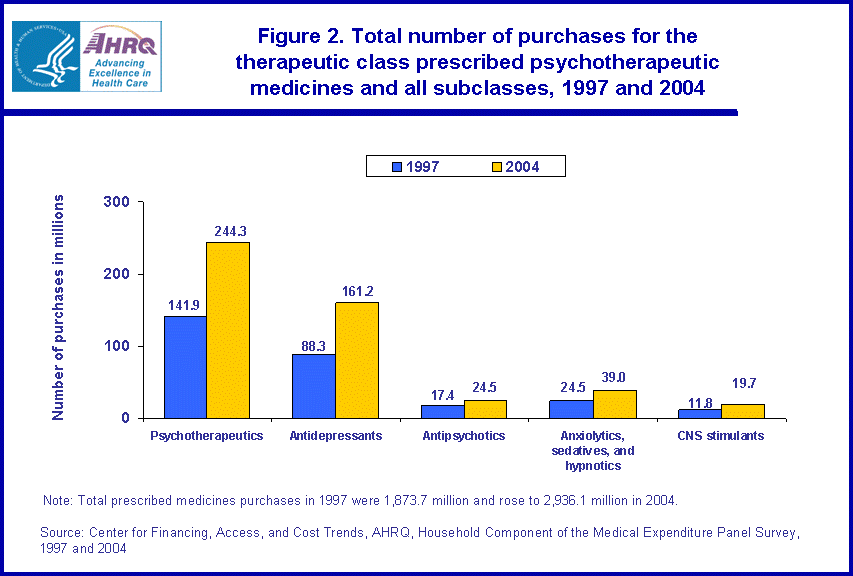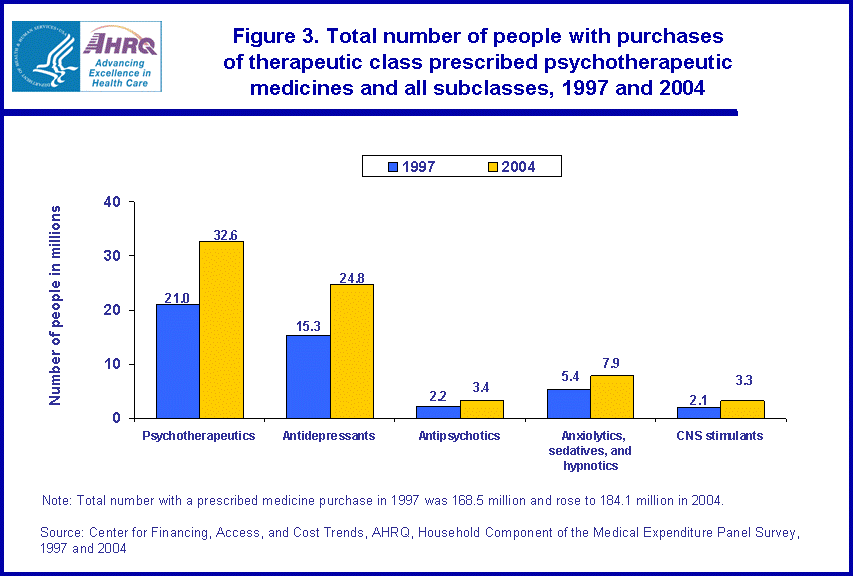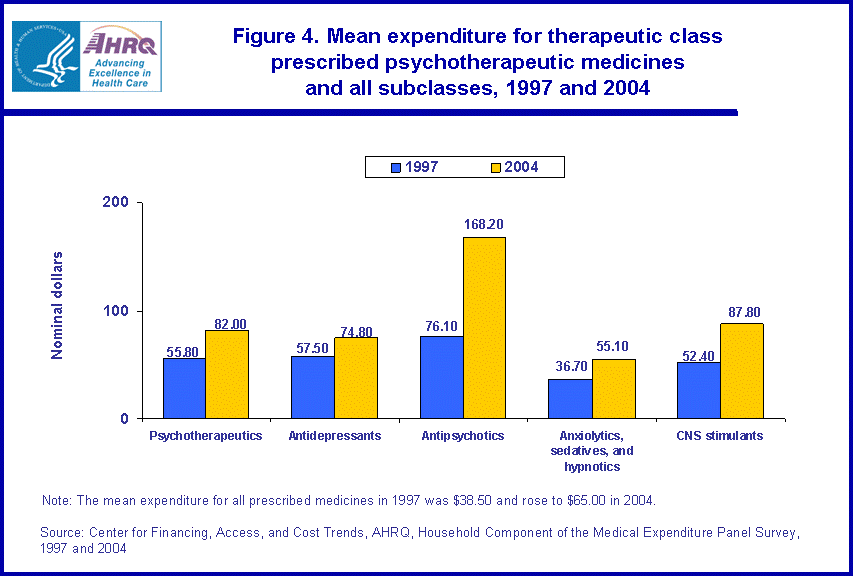
|
|
Font Size:
|
||||
|
|
|
|
||||
STATISTICAL BRIEF #163:
Trends in the Use and Expenditures for the Therapeutic Class Prescribed Psychotherapeutic Agents and All Subclasses, 1997 and 2004
Highlights
- Total expenditures in 2004 were at least 2.5 times as high as in 1997 for prescribed psychotherapeutic agents, increasing from $7.9 billion in 1997 to $20.0 billion in 2004.
- From 1997 to 2004, for the subclasses within the therapeutic class of psychotherapeutic agents, total expenses approximately tripled for CNS stimulants (from $0.6 to $1.7 billion) and antipsychotics (from $1.3 to $4.1 billion) and approximately doubled for anxiolytics, sedatives, and hypnotics (from $0.9 to $2.1 billion) and antidepressants (from $5.1 to $12.1 billion).
- Total prescribed medicine purchases for the therapeutic class of psychotherapeutic agents increased substantially from 1997 to 2004 (from 141.9 to 244.3 million), as they did for two subclasses within that class (CNS stimulants, from 11.8 to 19.7 million, and antidepressants, from 88.3 to 161.2 million).
- When comparing 1997 and 2004, the total number of people purchasing at least one prescribed medicine increased for the therapeutic class of psychotherapeutic agents (from 21.0 to 32.6 million) and for all subclasses within it (anxiolytics, sedatives, and hypnotics, from 5.4 to 7.9 million; CNS stimulants, from 2.1 to 3.3 million; antidepressants, from 15.3 to 24.8 million; and antipsychotics, from 2.2 to 3.4 million).
- When comparing all subclasses within the therapeutic class of psychotherapeutic agents from 1997 to 2004, the average price per purchase increase was the greatest for antipsychotics, which more than doubled, rising from $76.10 to $168.20.
Introduction
This Statistical Brief compares 1997 and 2004 data for the U.S. civilian noninstitutionalized (community) population from the Household Component of the Medical Expenditure Panel Survey (MEPS-HC) on total expenditures, total number of purchases, total number of people with a purchase, and average price per purchase for the therapeutic class of prescribed psychotherapeutic agents and all therapeutic subclasses within the class. The subclasses include antipsychotics; central nervous system (CNS) stimulants; antidepressants; and anxiolytics, sedatives, and hypnotics.
Only prescribed medicines purchases in an outpatient setting are included in the estimates presented in this brief. Insulin and diabetic supplies and equipment are included in MEPS prescribed medicines estimates. Over-the-counter medicines are excluded from these estimates as are prescription medicines administered in an inpatient setting or in a clinic or physician's office. Expenditures are in nominal dollars. All differences discussed in the text are statistically significant at the 0.05 level.
Findings
Therapeutic class of psychotherapeutic agents
In 2004, total expenditures on prescribed psychotherapeutic agents was at least 2.5 times as high as in 1997, rising from $7.9 billion to $20.0 billion (figure 1). In the same time span, the total number of purchases of psychotherapeutic agents increased substantially from 141.9 million purchases to 244.3 million purchases (figure 2). The total number of persons reporting purchasing a psychotherapeutic medicine rose from 21.0 million people to 32.6 million people (figure 3). Finally, from 1997 to 2004, the average per purchase drug expenditure for a psychotherapeutic agent increased from $55.80 to $82.00 (figure 4).
Therapeutic subclass of antidepressants
From 1997 to 2004, total expenditures on antidepressants more than doubled, rising from $5.1 billion to $12.1 billion (figure 1). The total number of purchases of antidepressants rose from 88.3 million purchases to 161.2 million purchases (figure 2), and the total number of persons reporting purchasing an antidepressant increased from 15.3 million people to 24.8 million people in the same time span (figure 3). Finally, the average per purchase drug expenditure for an antidepressant rose from $57.50 to $74.80 (figure 4).
Therapeutic subclass of antipsychotics
From 1997 to 2004, total expenditures on prescribed antipsychotics tripled, rising from $1.3 billion to $4.1 billion (figure 1). In the same time span, the total number of purchases of antipsychotics increased from 17.4 million purchases to 24.5 million purchases, and the total number of persons reporting purchasing an antipsychotic medicine rose from 2.2 million people to 3.4 million people (figure 2 and figure 3). Finally, the average per purchase drug expenditure for an antipsychotic more than doubled, going from $76.10 to $168.20 (figure 4).
Therapeutic subclass of anxiolytics, sedatives, and hypnotics
From 1997 to 2004, total expenditures on prescribed anxiolytics, sedatives, and hypnotics doubled, going from $0.9 billion to $2.1 billion (figure 1). In the same time span, the total number of purchases of anxiolytics, sedatives, and hypnotics increased from 24.5 million purchases to 39.0 million purchases (figure 2); whereas the total number of persons reporting purchasing an anxiolytic, sedative, or hypnotic medicine increased from 5.4 million people to 7.9 million people (figure 3). Finally, the average per purchase drug expenditure for a drug in the anxiolytics, sedatives, and hypnotics therapeutic subclass increased from $36.70 to $55.10 (figure 4).
Therapeutic subclass of CNS stimulants
From 1997 to 2004, total expenditures on CNS stimulants nearly tripled, rising from $0.6 billion to $1.7 billion (figure 1). Over the same period, the total number of purchases of CNS stimulants increased substantially, from 11.8 million purchases to 19.7 million purchases (figure 2), and the total number of persons purchasing at least one CNS stimulant increased from 2.1 million people to 3.3 million people (figure 3). Finally, the average per purchase drug expenditure for a CNS stimulant purchase rose from $52.40 to $87.80 (figure 4).
Definitions/Methodology
Therapeutic class and subclass were assigned to MEPS prescribed medicines using Multum Lexicon variables from Cerner Multum, Inc. MEPS prescribed medicines files were linked to the Multum Lexicon database to obtain therapeutic class and subclass variables. All psychotherapeutic agents in MEPS were defined as those events assigned the therapeutic class (TC1=242) in the Multum Lexicon database. In the Multum Lexicon database, all prescribed medicines assigned the psychotherapeutic class were further assigned one of the following subclasses: antidepressants (TC1S1=249); antipsychotics (TC1S1=251); anxiolytics, sedatives, and hypnotics (TC1S1=67); and CNS stimulants (TC1S1=71). For additional information on these and other Multum Lexicon variables, as well as the Multum Lexicon database itself, please refer to the following Web site: http://www.multum.com/Lexicon.htm.
Use was defined as one or more purchases of a prescribed medicine in a therapeutic class or subclass of interest. Individuals were classified as using a prescribed medicine of interest if they had one or more purchases of a drug in a class or subclass of interest during the year.
Expenditures are in nominal dollars.
Insulin and diabetic supplies and equipment are included in MEPS total prescribed medicines estimates.
About MEPS-HC
MEPS-HC is a nationally representative longitudinal survey that collects detailed information on health care utilization and expenditures, health insurance, and health status, as well as a wide variety of social, demographic, and economic characteristics for the civilian noninstitutionalized population. It is cosponsored by the Agency for Healthcare Research and Quality and the National Center for Health Statistics.
For more information about MEPS, call the MEPS information coordinator at AHRQ (301-427-1656) or visit the MEPS Web site at http://www.meps.ahrq.gov/.
References
For a detailed description of the MEPS survey design, sample design, and methods used to minimize sources of nonsampling error, see the following publications:
Cohen, J. Design and Methods of the Medical Expenditure Panel Survey Household Component. MEPS Methodology Report No. 1. AHCPR Pub. No. 97-0026. Rockville, Md.: Agency for Health Care Policy and Research, 1997.
Cohen, S. Sample Design of the 1996 Medical Expenditure Panel Survey Household Component. MEPS Methodology Report No. 2. AHCPR Pub. No. 97-0027. Rockville, Md.: Agency for Health Care Policy and Research, 1997.
Cohen, S. Design Strategies and Innovations in the Medical Expenditure Panel Survey. Medical Care, July 2003: 41(7) Supplement: III-5-III-12.
Suggested Citation
Stagnitti, M. N. Trends in the Use and Expenditures for the Therapeutic Class Prescribed Psychotherapeutic Agents and All Subclasses, 1997 and 2004. Statistical Brief #163. February 2007. Agency for Healthcare Research and Quality, Rockville, MD. http://www.meps.ahrq.gov/mepsweb/ data_files/publications/st163/stat163.shtml
AHRQ welcomes questions and comments from readers of this publication who are interested in obtaining more information about access, cost, use, financing, and quality of health care in the United States. We also invite you to tell us how you are using this Statistical Brief and other MEPS data and tools and to share suggestions on how MEPS products might be enhanced to further meet your needs. Please e-mail us at mepspd@ahrq.gov or send a letter to the address below:
Steven B. Cohen, PhD, Director
Center for Financing, Access, and Cost Trends
Agency for Healthcare Research and Quality
540 Gaither Road
Rockville, MD 20850
 |
||||||||||||||||||||||||||||||
|
||||||||||||||||||||||||||||||
|
|
||||||||||||||||||||||||||||||
 |
||||||||||||||||||||||||||||||
|
||||||||||||||||||||||||||||||
|
|
||||||||||||||||||||||||||||||
 |
||||||||||||||||||||||||||||||
|
||||||||||||||||||||||||||||||
|
|
||||||||||||||||||||||||||||||
 |
||||||||||||||||||||||||||||||
|
||||||||||||||||||||||||||||||
|
|
||||||||||||||||||||||||||||||


